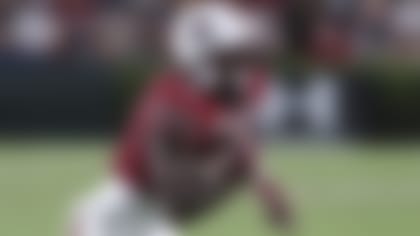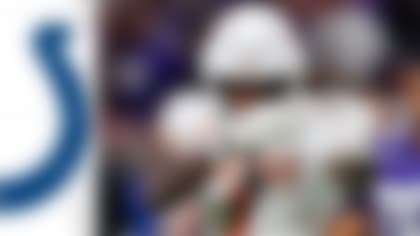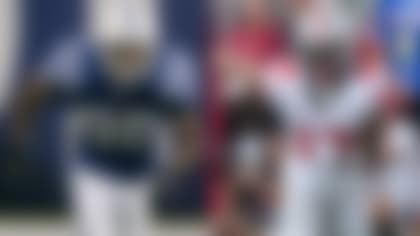INDIANAPOLIS -- Around this time last year, we witnessed the supposed demise of offensive tackle Andre Smith.
He showed up here at the NFL Scouting Combine out of shape, but he showed nonetheless -- for awhile. At some point in this highly valued process, he ducked out of town without telling anyone, skyrocketing concern that he was immature and undisciplined.
More alarms sounded when Smith ran a topless 40-yard dash at his pro day, exposing tremors of flesh across his supposedly refined torso (If he looked that bad then, how bad was it before he started his crash-training course?). Then he switched agents a few times, causing doubt as to whether he was stable enough to make it in the NFL.
Even with all that uncertainty looming over him, the Cincinnati Bengals drafted Smith sixth overall, evidence that tackles in the NFL have become as valuable as air.
In the past two years, 12 tackles have been drafted in the first round -- seven in the top 15, four in the top eight. No other position has been as coveted. Not even close.
The eight first-round offensive tackles selected in 2008 were equal to or more than the total number of quarterbacks (five), running backs (eight), defensive ends (eight), wide receivers (six), linebackers (five), cornerbacks (six) and defensive tackles (five) taken in the first rounds of the previous two drafts.
That number, when it comes to tackles, will grow larger in late April, when possibly four get selected in the top 10 and even more could be chosen later in the first round. Oklahoma State's Russell Okung, Oklahoma's Trent Williams, Rutgers' Anthony Davis, Iowa's Bryan Bulaga, and Maryland's Bruce Campbell are projected as impact tackles who could be selected early.
"Look at the ruling in the NFL and how they want to protect the quarterback," 49ers coach Mike Singletary said. "If you're calling the quarterback the most important player, if you look at it like, 'If we don't have that guy we're not going anywhere,' then you want to get those guys who can protect him.
"That left tackle, it starts with him. He has to set the tone for that because that's normally where that pass rush is coming from, and it's coming in fast to get your best guy. You want to eliminate that, slow it down. So you want to get the best guy you can to get that done."
Like San Francisco, five other teams choosing in the top 13 -- Washington, Kansas City, Seattle, Oakland and Buffalo -- are in need of offensive linemen, particularly tackles. None of those teams was among the top 20 offenses and all have several areas to upgrade. But landing an anchor tackle is a safe place to start. Pittsburgh and Green Bay also need to address their shortcomings at some point.
Making the selection of a tackle possibly more paramount, there likely won't be many -- if any -- of note that will come available on the free-agent market.
The expected failure to reach a new labor agreement by March 5 will trigger numerous restrictions on player movement, diminishing the attraction of pursuing a starting offensive tackle in free agency. To further the point, aging veterans Mike Gandy, Jon Jansen, Chad Clifton, Mark Tauscher and Tony Pashos will be among the more notable unrestricted free agent tackles, making the draft a far more beneficial option.
"So far, it looks like a really good (group) that's probably ready to play, and there's a good developmental group," Chiefs general manager Scott Pioli said of this draft's tackle class.
Drafting a tackle also could be more viable based on recent history. All eight drafted in the first round in 2008 -- Jake Long, Ryan Clady, Branden Albert, Chris Williams, Gosder Cherilus, Jeff Otah, Sam Baker, and Duane Brown -- are entrenched as starters. Of last season's group, Jason Smith, Eugene Monroe, the Bengals' Smith and Michael Oher started some, if not all season. Oher, chosen 23rd by Baltimore, was one of the NFL's top rookies.
A group of second-rounders from last year, including Eben Britton, Phil Loadholt, Sebastian Vollmer, and William Beatty, also started portions of 2009.
Pioli said many of those tackles were ready to start upon arrival. Others learned quickly and were able to pair their physical prowess with coaching. And others, well, they may be playing or starting by default.
An increasing number of tackles are coming into the NFL more prepared to pass protect than ever before, which is why so many teams are more comfortable putting them in the starting lineup, Singletary said. A tackle who has played from wide splits in a spread offense and who has shown the athletic ability to pass protect in space, and then to use him in more confined quarters along an NFL line of scrimmage, it makes the transition easier for the player and less risky for the team, the 49ers coach added.
To Singletary, though, that's what makes the evaluation process more difficult. He wants his offense to run the ball at least as much as it throws, so finding a tackle that's both physical and athletic is important. If one of those tough guys can be found, moving a collegiate left tackle to right tackle, like several teams did with their highly-drafted tackles the past two seasons, could be better for the offense, even though the left tackle carries more prestige for protecting a quarterback's blind side.
"If you have a team that's more pass-oriented, the left tackle is what you're going to look at," Singletary said. "If you're a team like Baltimore that's more of a balanced type of offense, the right tackle is just as important as the left tackle. You want to run the ball. It depends on the philosophy of the team and how much they need to protect the quarterback, how much he's going to be in a five-step drop, a seven-step drop.
"Teams like Baltimore, and I should throw us in there as well, we're going to pass off the run, play-action. You're going to be more balanced. Yes, you need that left tackle, but the left tackle is not as important as it is to a team like Indianapolis, where you really need to protect the quarterback."




